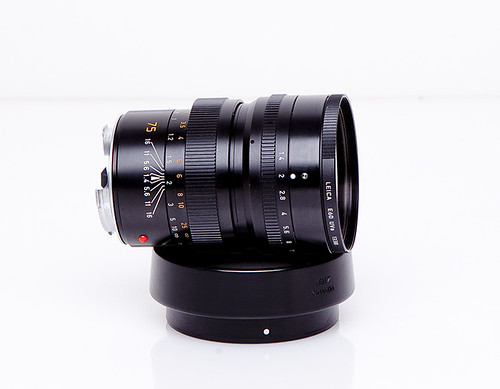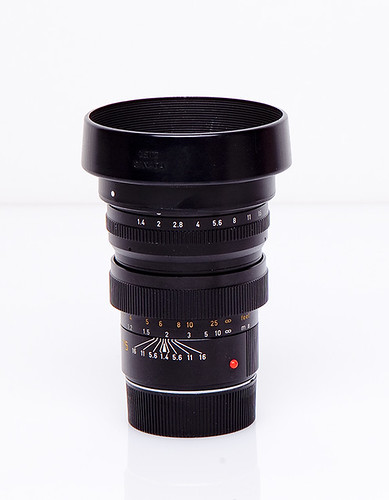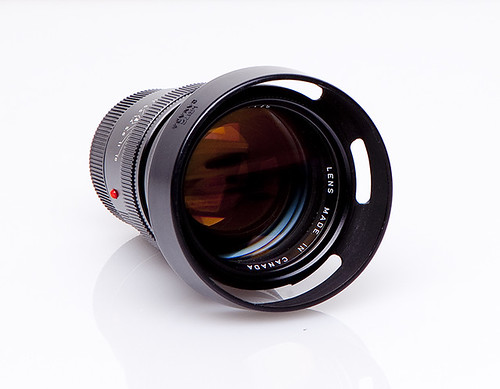Summilux-M 75 mm f:1,4
Características
Código - 11 814 - 11 815 - 11 810 LLC - 165
Producción - 1980-2007 < 14,752 ejemplares
Variaciones:Negro, titanio; ELC, ELW, 1913-1983; después de 1982 parasol telescópico #11 815
Montura -Bayoneta Leica M,codificación 6 bits en 2006
Angulo de visión diagonal, horizontal, vertical: 35 mm (24 x 36 mm) : 32º, 27º, 18º, - LEICA M8 (18 x 27 mm) : 24.4º, 20.4º, 13.7º,Diseño Óptico:
Número de lentes/grupos - 7/5Intérvalo de enfoque: - 0,75 m a infinito
Longtud focal efectiva -
Posición de la pupila de entrada -29.9 mm (respecto a la primera superficie de lente en la dirección de la luz)
Escalas: combinada, metros/pies
Campo visual mínimo: 192 mm x 288 mm
Factor de reproducción: 1:8
Diafragma - f/1,4-f/16 con click, valores intermedios, diafragma manual tipo iris DE 10 hojas
Montura de filtros: rosca E60
Parasol: 12539 (1ªversión)
Longitud hasta la bayoneta - 80 mm
Diámetro máximo - 69 mm
Material: Alumino
Peso - aprox. 345 g
Inscripción - LEICA LENS MADE IN CANADA 1:1.4/75 E60 SUMMILUX-M XXXXXXX
LEITZ SUMMILUX-M 1:1.4/75 E60 325XXXX
LEICA SUMMILUX-M 1:1.4/75 E60 395XXXX
Diseño: Walter Mandler
[URL="https://flic.kr/p/phrG4L"]
Efrain G, en Flickr
Referencias
Descripción
In the mid-1970s the sales of the Leica rangefinder camera were at a low point. The Leica M5 sold on average 6000 units a year and that was too little to support a full production street. Costs soared and the decision was made to transfer production to Midland, Canada.
The M4-2 however did not fare much better. New lenses were needed for turning the tide and increase the versatility of the CRF-system. Filling slots in the lens range and emphasizing the M-camera as the available-light reportage camera the focal length of 75 mm was a serious option.
The Canadian designers could easily adapt the lens prescription of the Summilux (II) 50 mm and doing so had a cost-effective additional lens in the range. The similarity in design implies a comparable fingerprint and that is the case.
The Summilux-M 75 mm at maximum aperture is a medium-contrast-medium-definition lens, but improves rapidly on stopping down. Flare is well suppressed, but the outer zones of the picture area say soft which is not a problem considering the kind of pictures that are preferably made with this lens.
In 1935 Leitz made a special lens for X-ray and television recording: the Summar 0.85/75 mm (serial numbers: 240.561 - 240564). At maximum aperture the depth of field was 8 mm (!) at a distance of 1 meter.
The Summilux-M 75 mm had the second highest price tag in the lens line around 2000 (the Noctilux was a shade more expensive). The lens was a steady but slow seller and about 13000 units have been allocated over a period of almost 25 years. Its special fingerprint of smoothness of fine detail and subtle color hue at maximum aperture predestines the lens for candid head-and-shoulder portraiture where almost Summicron-quality can be expected.
Ésta página ha sido vista 2.097 veces
-
-
Creado por elultima actualización por , el
-




